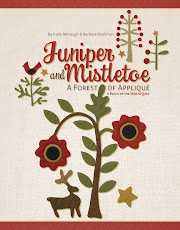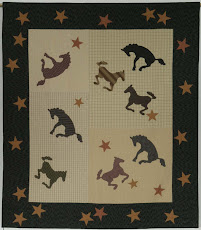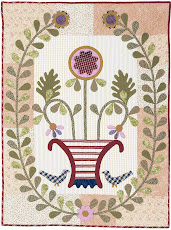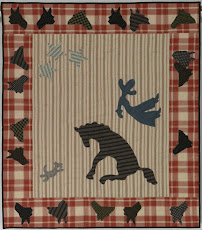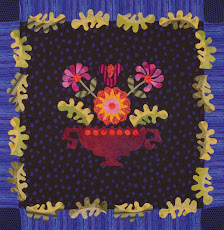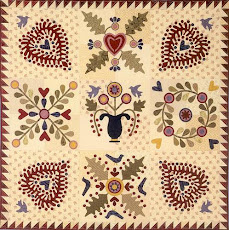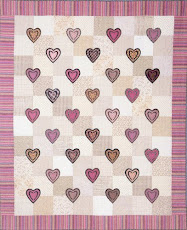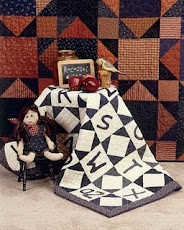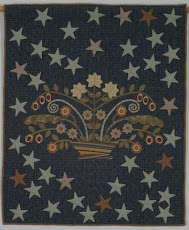Thanks so much to those of you who commented on my last blog. As a new blogger, I have to tell you that it's so encouraging to hear from people who are reading the blog!
At least one person commented on all the berries in Abiding Joy, leading me to my next subject — how much I love berries!
To me, a quilt can never have enough berries. Not only do I love the visual interest they add to a design, I also love making them.
That wasn't always the case. My first attempt at berry-making was in the late 1990s, when the members of the Kaw Valley Quilter's Guild in Lawrence, Kansas, were making Floral Bouquet* for a fund-raising project. To create the 300-400 berries for this quilt, the project designers and chief appliqué artists, Shirley and Shirlene Wedd, asked volunteers to make small yo-yos from nickel-sized fabric circles. I agreed to make about 20 yo-yos. Aack! I had never worked with circles that small, and I was horrified by the misshapen lumps I created. I tried remaking some but with no better results, so finally I just turned them in "as is." After the quilt top was finished, I asked Shirley if she had been able to use all the yo-yos that the volunteers had made. I thought she'd say "All but 20." But instead she just laughed and said that she and the other appliquérs had been able to smooth out all the edges as they hand-stitched them to the background fabric. I was so impressed!
Now that I've learned to machine appliqué, I can make nearly perfect berries by using paper circles as the basis for each berry. When the berries are a standard office-dot size — 1/2", 3/4" or 1" — I use white removable office dots. For berries of other sizes, I use a circle template to draw the berries onto freezer paper. I stick or iron the paper dot or circle onto the back of my fabric and cut the fabric out with a scant 1/4" seam allowance. Then I apply a white glue stick to the back of the circle and use the sharp point of my Clover seam ripper to fold and gather the seam allowance to the back of the dot. With the sharp point of the seam ripper, I am able to make tiny tucks as I gather the seam allowance, creating a really smooth edge to the circle. The paper backing holds the edge in place as I stitch around it, and it's easy to remove the paper later. Now I think I can make any quilt design I want, no matter how many berries!
When I am lucky enough to attend my old quilt group meetings in Kansas (I now live in Kentucky), my friend Barbara brings me a plastic baggie of white office dots and some fabric scraps so I can make berries while I talk to my friends. (If only I were organized enough to bring my own projects to work on, but usually just getting to Kansas has used up all my organizational skills. Oh well, a subject for a different blog.) Making berries is one of the perfect quilt group activities — the rhythm of making the circles is relaxing, and it leaves my mind free to concentrate on friends and conversation. I leave the bag and the stitch-ready circles with Barbara, with full expectation of seeing all my beautiful dots on one of her quilts some day.
*When Barbara and I published Floral Bouquet as a 4-part block-of-the-month series in 1999, we changed the original berry pattern to 3/4" finished berries. The originals were a little smaller, about 5/8" depending on the individual yo-yo maker's stitching.
The original quilt was very popular. Elly Sienkiewicz included a picture of it in her book The Best of the Baltimore Beauties, and a beautiful version made by Karen Lipp of Rapid City, SD, was in the 2008 Quilt Art Engagement Calendar. We still have a few patterns left; if you're interested write me at kcmenaugh@sunflower.com.
Sunday, December 20, 2009
Saturday, December 12, 2009
A Quilter's Mise en Place
I just finished watching this season's finale of Top Chef (No, I'm not going to discuss the winner; that would be the subject for an entirely different blog!).
But the show made me think about the similarities between the culinary process and quilting, specifically mise en place. This French phrase literally means "putting in place." In the culinary world, this term has come to represent the part of the process where the chef or assistants dice mounds of vegetables, prepare proteins, set out spices, utensils, and other equipment, and in general assemble everything they will need to complete their final dish. I recall last summer's Top Chef Masters, where noted chef Hubert Keller prepared a vegetable dish in which he scored the carrots before slicing them, so the resulting medallions resembled little flowers. His devotion to detail makes me think that he and other chefs take just as much care and pleasure in these preliminary steps as they do in actually cooking the food, plating it, and presenting their masterpieces to their diners.
Back to quilting. I must admit, one of my favorite parts of making a quilt is hand-stitching the binding to the back of the quilt. As I stitch the final edge of the quilt, I see my project literally change from a work-in-progress (or sometimes long-time UFO) to a finished quilt that can be hung on the wall, slept under, and generally loved and cherished for generations (I hope). I think of this step as similar to the chef's putting the final garnishes on the plate before it's sent out to the dining room.
But I also love getting all the materials ready so that I can start sewing my blocks. In my machine appliqué technique, this involves sending yards of bias strips through a bias-tape maker and cutting out every appliqué shape from freezer paper before ironing the shapes onto fabric, cutting them out, and gluing the seam allowances to the back of the freezer paper. This is the stage where I select the fabric that has the perfect color and texture for every element of the quilt, so it's artistically satisfying to see all those elements start to come together. Sometimes I do part of the work in stitch group, where friends and conversation sweeten the process.
Here's my mise en place for a red-and-green quilt I made a few years ago for our book Cranberry Collection. The quilt, which I named Abiding Joy, contained 520 3/4" berries and miles of 1/4" bias vines. I loved assembling these stacks of background blocks, design elements, and vines. I made many of the berries while sitting in the driver's seat of my car (not driving!), waiting in the parking lots of various ball parks while my son's team warmed up or practiced. It was so wonderful to have everything ready to create the actual blocks!
Here's hoping that you gain joy from each part of the process, too.
Karla
But the show made me think about the similarities between the culinary process and quilting, specifically mise en place. This French phrase literally means "putting in place." In the culinary world, this term has come to represent the part of the process where the chef or assistants dice mounds of vegetables, prepare proteins, set out spices, utensils, and other equipment, and in general assemble everything they will need to complete their final dish. I recall last summer's Top Chef Masters, where noted chef Hubert Keller prepared a vegetable dish in which he scored the carrots before slicing them, so the resulting medallions resembled little flowers. His devotion to detail makes me think that he and other chefs take just as much care and pleasure in these preliminary steps as they do in actually cooking the food, plating it, and presenting their masterpieces to their diners.
Back to quilting. I must admit, one of my favorite parts of making a quilt is hand-stitching the binding to the back of the quilt. As I stitch the final edge of the quilt, I see my project literally change from a work-in-progress (or sometimes long-time UFO) to a finished quilt that can be hung on the wall, slept under, and generally loved and cherished for generations (I hope). I think of this step as similar to the chef's putting the final garnishes on the plate before it's sent out to the dining room.
But I also love getting all the materials ready so that I can start sewing my blocks. In my machine appliqué technique, this involves sending yards of bias strips through a bias-tape maker and cutting out every appliqué shape from freezer paper before ironing the shapes onto fabric, cutting them out, and gluing the seam allowances to the back of the freezer paper. This is the stage where I select the fabric that has the perfect color and texture for every element of the quilt, so it's artistically satisfying to see all those elements start to come together. Sometimes I do part of the work in stitch group, where friends and conversation sweeten the process.
Here's my mise en place for a red-and-green quilt I made a few years ago for our book Cranberry Collection. The quilt, which I named Abiding Joy, contained 520 3/4" berries and miles of 1/4" bias vines. I loved assembling these stacks of background blocks, design elements, and vines. I made many of the berries while sitting in the driver's seat of my car (not driving!), waiting in the parking lots of various ball parks while my son's team warmed up or practiced. It was so wonderful to have everything ready to create the actual blocks!
Here's hoping that you gain joy from each part of the process, too.
Karla
Thursday, December 10, 2009
Welcome to My Blog
I love appliqué, but I have some problems with my hands that make it hard for me to do nice hand appliqué. So I work with a technique that helps me to use a special machine stitch to make quilts that are just as beautiful and durable as hand-appliquéd quilts.
During the past 10 years, I have had the fortune to work with quilt historian Barbara Brackman in designing quilt patterns that we published through the Sunflower Pattern Co-operative and the Kansas City Star (See column at left for more information.). What an opportunity! Barbara brings such a rich historical and artistic perspective to every project, and it has been fun to combine our quilt design ideas with the fabrics she designs for Moda. Most of our books and patterns give some tips about the machine techniques, and one — Quiltmaker's Guide to Fine Machine Appliqué — contains all my techniques and special tips.
So, I've had a decade of opportunities to indulge in my love of reproduction and folk art designs. I hope to share some of those reproduction designs and inspirations in this blog, and to pass along some tips for the machine appliqué techniques that have worked so well for me.
Happy quilting!
During the past 10 years, I have had the fortune to work with quilt historian Barbara Brackman in designing quilt patterns that we published through the Sunflower Pattern Co-operative and the Kansas City Star (See column at left for more information.). What an opportunity! Barbara brings such a rich historical and artistic perspective to every project, and it has been fun to combine our quilt design ideas with the fabrics she designs for Moda. Most of our books and patterns give some tips about the machine techniques, and one — Quiltmaker's Guide to Fine Machine Appliqué — contains all my techniques and special tips.
So, I've had a decade of opportunities to indulge in my love of reproduction and folk art designs. I hope to share some of those reproduction designs and inspirations in this blog, and to pass along some tips for the machine appliqué techniques that have worked so well for me.
Happy quilting!
Subscribe to:
Comments (Atom)






